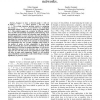Free Online Productivity Tools
i2Speak
i2Symbol
i2OCR
iTex2Img
iWeb2Print
iWeb2Shot
i2Type
iPdf2Split
iPdf2Merge
i2Bopomofo
i2Arabic
i2Style
i2Image
i2PDF
iLatex2Rtf
Sci2ools
126
click to vote
JSAC
2008
2008
Randomized consensus algorithms over large scale networks
Suppose we have a directed graph G with set of nodes V = {1, . . . , N} and a measure xi for every node i V . The average consensus problem consists in computing the average xA = N-1 P i xi in an iterative way, exchanging information among nodes exclusively along the available edges in G. This problem appears in a number of different contexts since the 80's (decentralized computation, load balancing, clock syncronization) and, recently, has attracted much attention for possible applications to sensor networks (data fusion problems) and to coordinated control for mobile autonomous agents. Several algorithms for average consensus can be found in the literature: they differentiate on the basis of the amount of communication and computation they use, on their scalability with respect to the number of nodes, on their adaptability to time-varying graphs, and, finally, they can be deterministic or random. In this presentation we will focus on random algorithms: we will review some algor...
Related Content
| Added | 13 Dec 2010 |
| Updated | 13 Dec 2010 |
| Type | Journal |
| Year | 2008 |
| Where | JSAC |
| Authors | Fabio Fagnani, Sandro Zampieri |
Comments (0)

